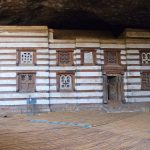The celebration of Maskal
Maskal is an ancient seasonal rite celebrated throughout Ethiopia for centuries and is one of the most important annual festivals. The 26th September is the eve of Maskal, a feast commemorating the Finding of the True Cross.
The biggest and the official occasion takes place at the Maskal square in Addis Ababa, near the church of Saint Estifanos. A colorful procession of priests, deacons and choir boys and girls of Sunday schools wearing embroidered robes walk around a huge pyre, bearing ceremonial crosses and wooden torches decorated with olive leaves. As the sun begins to set, the torch-bearers move forward in unison to set alight the slender pyramid-shaped structure, topped with a cross made from the yellow flowers known as Maskal daisies which are placed on the tallest central pole.
The origins of the celebration are expressed in the Ethiopian manuscript of parchment. The celebration is associated to the discovery of the Byzantine Queen of Helena of the cross on which Jesus Christ was crucified. According to the manuscript, in the 20th year of the reign of her son Constantine, she set off for Jerusalem search of the ‘life giving cross’, which she eventually found after many trials and tribulations. She is said to have forced the Jews to reveal the whereabouts of this ’Honorable Cross’, which allegedly lay under the hill of Golgotha, formed from sweepings, ashes and offal piled on the grave of Jesus Christ.
Helena is said to have found the Cross by lighting incense and following the smoke as it descended to earth. She caused bonfires to be lit on the hills of Palestine which could be seen across the sea by the people of Constantinople.
According to Tefut, a massive volume dating from the 15th Century parchment that record the detailed story of the acquisition of a fragment of the true Cross by Ethiopia. The Christian kings of Ethiopia were often called upon in the early Middle Ages to protect Egyptian Copts against the Egyptian Muslims. In return for this delivery from Muslim persecution, fabulous gifts of precious gold were offered to Ethiopian Emperor Dawit. He rejected these offerings and asked instead for pieces of the True Cross, which were under the custody of the patriarch of Alexandria. The request was granted and the pieces brought to Ethiopia. They were guarded on the journey by torchbearers and then deposited in a church at Gishen, in northern Wollo dedicated to the Virgin Marry. Rejoicing followed throughout the whole country and the Emperor ordered that the capes of the priests be embroidered with flowers. Since that day, Ethiopian Christians are believed to have commemorated the occasion with flaming torches and huge bonfires.
Emperor Dawit’s fourth son, Zara Yacob, succeeded him as emperor and, when he was a very old man, dreamt that God ordered him to ‘place a cross upon a cross.’ Zara Yacob spent two years in abstinence, searching in seclusion, and at least discovered a mountain shaped like a cross. There he built the beautiful church of Egziabher Ab, and a fragment of the True Cross was kept within a gold box in the church. The priests of Gishen still safeguard this treasure along with the Tefut which has handwritten in Ge’ez on beautiful parchment.
Today Maskal is a religious and joyful annual social occasion that Christians throughout the country look forward to each year. Both women and men wear their national clothes, while youths boast and compete in fights with sticks. There is also jesting as well as flirting and courting sanctioned by the festival. These days, people return from the capital parade to their houses and bring the torches called chibbo, to neighborhood bonfire gatherings. The torchbearers chant as they circle the pyre, the Damera, (literally stack or pile of wooden torches), which are covered with cloth until a priest blesses it. The torchbearers then hurl their flames into the midst of the Dameras, while the gathering watches the blaze light up the night sky.
On the following day people go to the bonfire and make the sign of the cross on their foreheads with the ash.
Source: Authority for Research and Conservation of Cultural Heritage



Leave a Reply